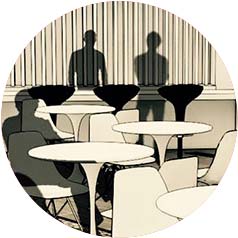When buildings dance?
As dusk fell behind the skyscrapers of Hong Kong Island, lights twinkled along its skyline. As music invaded the air, punctuated by coloured laser patterns, the buildings of steel and glass swayed, moved, rose and fell as if in a choreographed piece. The brawny HSBC buildingorchestrated the rhythms that were sinuously picked up byBank of China and then twirled in the colours that descended into the waters of the bay. The entire architecture danced, rising slowly to a crescendo. At the end, the awed audience in Kowloon applauded in exhilaration. This is not a figment of the imagination but a daily occurrence in the island city — the Symphony of Lights, a 14-minute long permanent laser show that plays over the forest of skyscrapers along Hong Kong’s Victoria Harbour.
It is a show that, as if by magic, humanises the skyscraper, makes it an image that is no longer aloof, but reveals heart, character and even personality! It serves not merely as a mechanised function or as an iconic symbol of the urbanscape but opens itself to life that is the street, to a beat that is the city. Thereby, the show challenges detractors of the skyscraper who claim that it is no more than an opulent phallic symbol, vacuous in typology.
The “Manhattanisation” of the urban landscape has been much debated in India. Despite Mumbai leading India’s foray into the race for height with its latest addition, the India Tower, among its other innumerable high rises, tall buildings in the city lag way behind those in urban centres elsewhere such as the Taipei 101, Burj Dubai, Jin Mao tower and the Petronas, to name a few.
Ironically the prime reason for the growth of the vertical skyscraper was to accommodate the rising urban population in cities — a statistic in which Indian metros score higher than nearly all the other cities in the word. Yet, curiously we are nowhere to be seen even in the last lap of the height race. Why doesn’t India have skyscrapers?
Indian architects have inexplicably shied away from reaching for the sky, literally. In a world where the global urban population equals the entire population of the world in 1960 and the number of cities has grown from 85 to 550 in that time, are we not being severely myopic? Do Indian planners suffer from vertigo? Or, perhaps, it is part of a political conspiracy to keep us “grounded”?
Recently the Union urban development minister declared that New Delhi needed more “high rises”, opening what will be the equivalent of a Pandora’s Box of policy planning issues. The proposal questions the wisdom of adhering to the colonial Lutyen’s garden-city plans at a time the capital is commemorating its hundredth anniversary.
The arguments for avoiding skyscrapers are varied and range from the paucity of infrastructure, to a loss of an Indian aesthetic, cultural anomaly and even environmental damage. Ridiculously, it is not as if more infrastructure is needed to support tall buildings because the number of occupants in the city remain the same in any case. Building skyscrapers cannot, however, happen in the ad hoc manner that it does right now. As far as aesthetics goes, skyscrapers can in fact help to choreograph a skyline that represents the new aspirations and hopes of modern India.
Lastly, is it green? It has often been demonstrated that not only do skyscrapers allow for consolidation of transport and services, thus leading to conservation of natural resources, but also permit land below to be left free, encouraging the creation of public domains that are so important to a city.
The skyscraper has often been accused of being an isolated inversion of space that intrudes on urban equity. Yet the great Indian skyscraper could be the hero and perhaps herald a new form of architecture that is as much about the sky as it is about the street. It need not be a static monument but a dynamic structure that performs the electric antagonism between metropolis and architecture.
— Suparna Bhalla
Published on December, 17th 2011




























